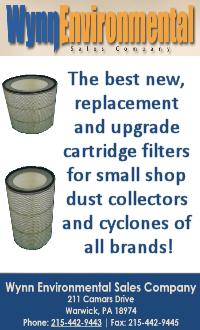Testing & Frequently Asked Questions
-
Testing
As part of my ongoing efforts to keep this information current, accurate and useful, I bought a set of top quality expensive digital air quality and airflow measurement test meters. I had hoped that the magazine testing would take over the testing of dust collectors, cyclones and air quality as my keeping up that testing was too expensive and hard on my not so great health. Unfortunately, after all but my cyclone design gravely failed the last set of magazine tests a decision was made to not share that last round of testing. I understand that no magazine would want to put out a review that showed their main advertisers as selling products with serious performance problems. Seeing that no new testing is expected in the near future, I chose to use my new meters and resume testing. I started by testing cyclones, dust collectors, and air quality for many of my friends to get my testing protocol refined. My friends surprised me as quite a few had excellent dust collection mostly due to lots of careful work on their parts. In fact, the only shop that used a dust collector that passed the relatively easy OSHA air quality standards belongs to one of my friends who vented outside. Some of my other friends also did excellent work with their smaller cyclones that they had either made or put together from commercial parts. Regardless, I then tested twenty eight shops in late 2006. All had 2006 model dust collectors and cyclones with the latest in filters. All except for the six made from my plans on these web pages are regularly advertised in small shop woodworking magazines. I focused on the biggest name advertisers testing at least one of each size of their most popular sized dust collectors and cyclones.
These test results were dismal. Not one under 3 hp dust collector or under 5 hp cyclone that vented inside stayed below the relatively easy OSHA air quality maximum after sawing just 54 linear feet of MDF. Only eight of the twenty eight shops I tested maintained airborne dust levels below OSHA standards. Only one major advertised brand of cyclone and one brand of dust collector succeeded, and both ran without filters venting outside. All six of the other cyclones that passed were either made from my design by the shop owner. Each of these cyclones not only passed the fairly easy OSHA air quality standards, all but one passed both the much harder ACGIH and medical air quality recommendations that are now the European standard.
I believe the issues are the same that I have been pushing hard since 1999. Over twenty years of air engineering and refinement by the dust collection firms whose customers must pass regular air quality testing shows that for good fine dust collection we must first fix our tool hoods to control the fine dust, move ample air to collect this dust, then get rid of that dust by either blowing it away outside or amply filtering the air before returning the air to our shops. Their testing and years of refinement makes it clear what we must do to fix our hoods. They likewise are clear we need to move about 800 CFM at our larger tools to provide ample dust collection to meet OSHA air quality standards, about 900 CFM to meet ACGIH recommendations, and about 1000 CFM at our larger tools to meet medical air quality recommendations. They likewise adhere to the ASHRAE standards that say we need to test filters used for indoor air when clean and new, not when they are at maximum efficiency after the six months to years it takes to build up a thick cake of dust in the filter pores that does not come out with normal cleaning. My particle counter showed all 2006 model filters freely passed the unhealthiest under 10-micron particles with most freely passing particles sized ten to twenty times larger than claimed in the small shop woodworker magazine ads.










